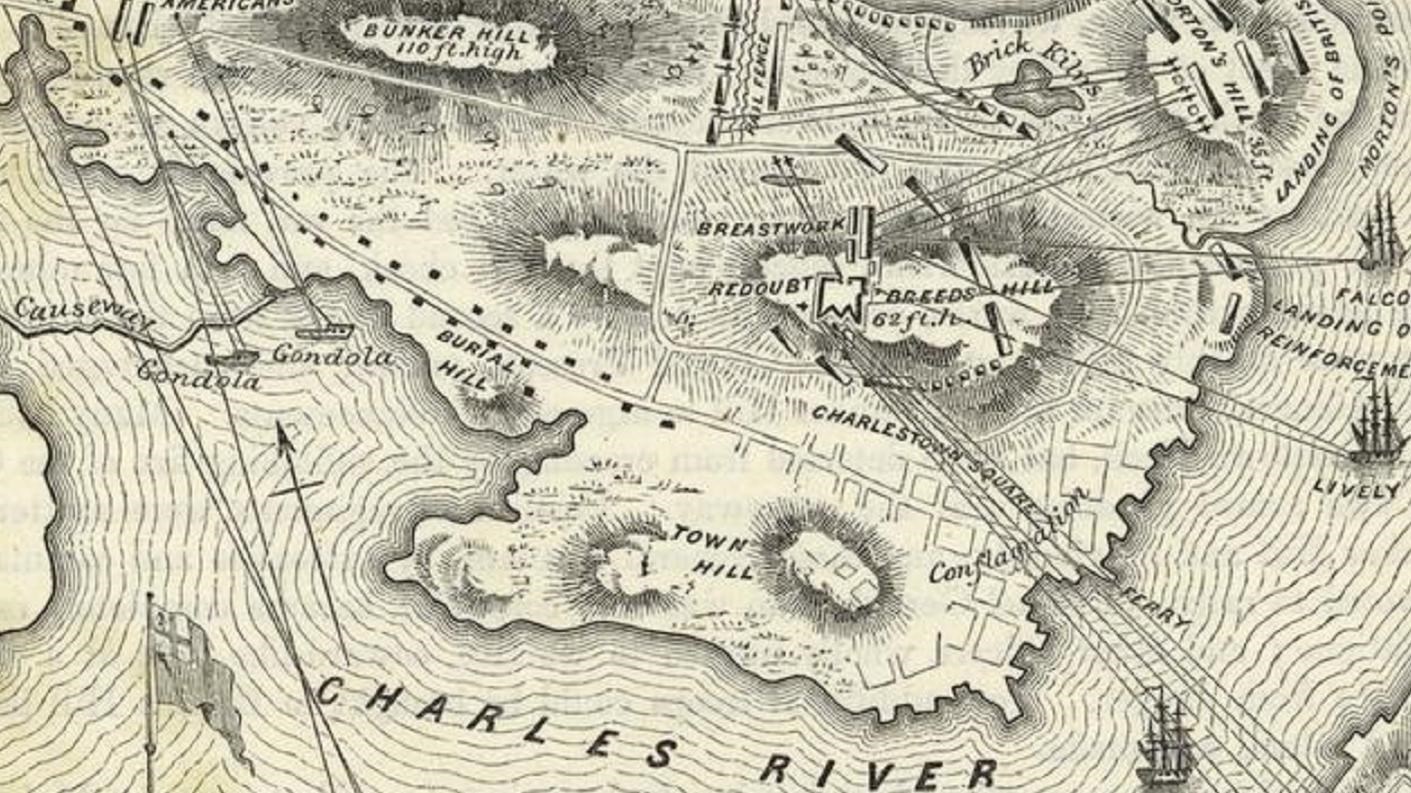Last updated: January 16, 2024
Place
Breed's Hill

The New York Public Library Digital Collections
Due to its close proximity to Boston and its pivotal role during the Battle of Bunker Hill, Breed's Hill in Charlestown is mostly remembered for its colonial and revolutionary ties. Settled by English colonists in 1625 and first known as "Cherton," Charlestown became an important location of craft production thanks to deposits of clay and other raw materials. Home to three hills, there have been disagreements about the names of these heights since the 1600s. According to historian Richard M. Ketchum:
To the south of it [Bunker Hill], and connected to it by a lower, sloping ridge, was a height of land not sufficiently distinguished to bear any particular name. Some called it Charlestown Hill; others, considering it an appendage of Bunker Hill, referred to it by that title; while some of the local people, out of deference to a farmer whose cattle grazed there, called it Breed’s. Its steep western flank, covered with orchards and gardens, leveled out near the settlement of Charlestown.1
By 1775, the population of Charlestown hovered around 2,000 to 3,000 people with 400 structures in it, mostly situated on the south shore facing Boston. Bunker and Breed's Hills, named after George Bunker and Ebenezer Breed, were mostly undeveloped with some farmhouses and pastures.2 Lacking trees along the hills, residents of Boston had an unobstructed view of the Charlestown Heights from the northern section of town.3
After the skirmishes at Lexington and Concord, both the British and colonial forces focused on defensible locations surrounding the town of Boston. As the colonials dug trenches in Roxbury and Cambridge, the British forces began to prepare to take both the Charlestown and Dorchester Heights: "First, a detachment would move out against Dorchester Neck, throw up two redoubts there, and then attack the rebel post at Roxbury. Once Boston was safe from attack in that direction, Howe would take a large force to Charlestown Heights and either attack the Americans in Cambridge or outflank that post." Planned for June 18, General Gage and his staff felt confident they would prevail by the end of the day.4
Learning of the plan, the colonial forces arrived at the Charlestown Heights first on June 16, 1775. Though there are conflicting reports of where the redoubt should have been placed, construction began around 12:30 am on June 17 at Breed's Hill. After building their defenses throughout the course of the day, the colonists held the high ground as the British troops landed along the Charlestown shoreline. Over the course of about two hours, the battle raged throughout the peninsula. Pitting 2,200 British troops against a varying number of Provincial (colonial) troops led by Colonel William Prescott, it would become one of the bloodiest battles of the American Revolution. Over 1,000 British soldiers, officers, and Marines were killed or wounded. Approximately 300 to 500 of the 1,400 to 1,800 provincial soldiers were killed, wounded, or captured. Breed's Hill would remain in the hands of the British Army until March 1776.5
Though the King Solomon's Lodge Masons dedicated a Monument dedicated to Joseph Warren in 1783, a new effort to honor all those who fought during the battle did not begin until the 1820s. On June 17, 1825, on the 50th anniversary of the battle, a large crowd gathered for a cornerstone-laying ceremony for the future Bunker Hill Monument located at the top of Breed's Hill. Among those present that day were the General Marquis de Lafayette and former Massachusetts senator, Daniel Webster. It took another 18 years for the Monument to be realized.6
Established on just four of the original 10 acres of the battle, the rest of the area soon became house lots and, eventually, the original Charlestown High School. Annexed by Boston in 1874, Charlestown became a popular neighborhood for working-class Irish immigrants.
In 1923, the Commonwealth of Massachusetts, then the caretaker of the Bunker Hill Monument, installed this plaque (below) on the exterior of the Bunker Hill Lodge adjacent to the Monument. Breed family members had appealed to the state, as they had previously appealed to the Bunker Hill Monument Association when the Association owned the Monument, that the name "Breed's Hill" was not displayed somewhere prominently on the hill. State officials agreed and installed this plaque.7

This plaque states: "Breed's Hill Site of the Battle of Bunker Hill Fought June 17, 1775 Although orders were issued by the Committee of Safety to Seize and Fortify Bunker Hill the Colonial Officers After Consultation Fortified this Hill on June 16, 1775." (NPS Photo).
Today, Breed's Hill hosts about 2% of the population of Boston with 18,058 residents.8
Footnotes:
- Richard M. Ketchum, Decisive Day: The Battle for Bunker Hill (New York: Henry Holt and Co., 1999) 106-107.
- Richard Frothingham, The History of Charlestown, Massachusetts (Santa Maria, CA: Janaway Publishing, 2016).
- National Park Service. “Bunker Hill (U.S. National Park Service).” Archeological Overview and Assessment, Bunker Hill Monument, January 2009. https://www.nps.gov/parkhistory/online_books/bost/bunker_hill.pdf.
- Ketchum, Decisive Day: The Battle for Bunker Hill.
- Please refer to the article The Battle of Bunker Hill, for an in-depth overview of the battle.
- National Park Service, “Building the Bunker Hill Monument (U.S. National Park Service),” National Park Service. U.S. Department of the Interior, October 1, 2021.
- "Fighting Bunker Hill Battle Again—With Ink," Boston Daily Globe, February 5, 1922, 45; Breed Family Association, Breed Family Association: [papers] (S.I. Association, 1922) Archive.org.
- City of Boston, “Neighborhood Profiles - Bostonplans.org,” August 2017. http://www.bostonplans.org/getattachment/7987d9b4-193b-4749-8594-e41f1ae27719.
